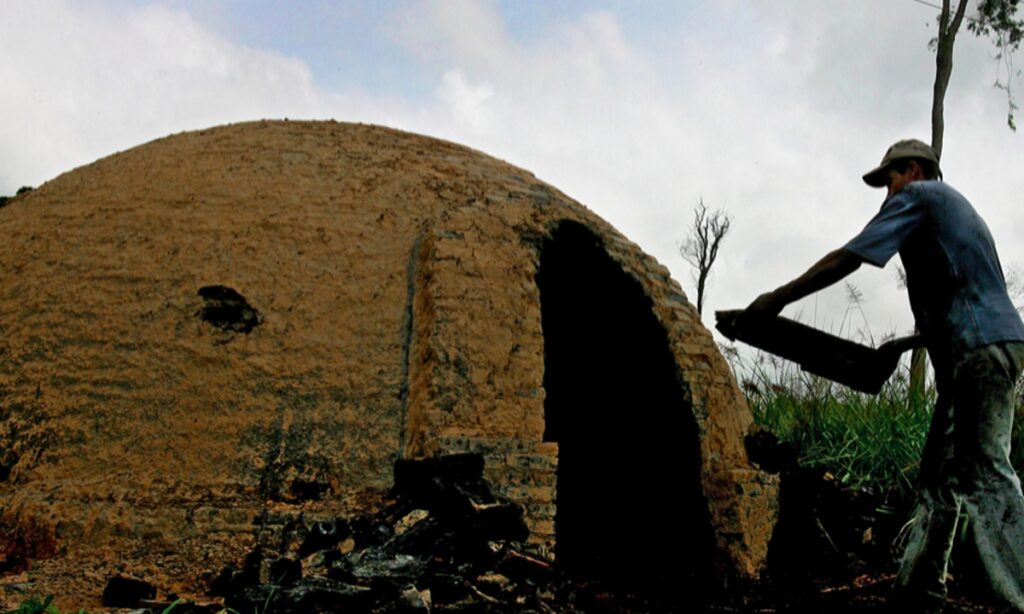In Brazil, charcoal industry fuels illegal deforestation and slavery
For more than a year, Antonio slept with a wasp nest humming above his head – not in the open but inside a small brick house on a farm a couple of hours from Brazil’s capital, Brasilia.
Outside, a dozen charcoal kilns burned wood day and night, filling the air with smoke, next to piles of logs illegally cut from the endangered Cerrado biome, South America’s largest savanna.
Antonio, who asked for his real name not to be disclosed, worked feeding native trees into the kilns to make charcoal.
That fuel, used by steel mills and for the traditional Brazilian barbecue, has links to both labor rights abuses and environmental violations.
Antonio and several other men were hired in the southeastern state of Minas Gerais for jobs in center-west Goias state where they were forced to work in conditions labor inspectors who found them in December 2021 described as “slavery-like.”
The two-bedroom house Antonio shared with five other men lacked electricity, clean water and a functioning bathroom. He worked from the morning to the night, he said, while taking medication for depression.
The wasps were the least of his worries. “I suffered worse than this,” he told the Thomson Reuters Foundation.
Globally, the wood fuel sector is a substantial source of the greenhouse gases heating up the planet and is estimated to account for up to 7 percent of total emissions from human activity, according to the UN Food and Agriculture Organization (FAO).
In 2015, Brazil was the world’s top producer of charcoal, the most recent available FAO data shows.
Brazil’s steel mills rely on charcoal, much of which is made from native forests, said Roberto Kishinami, energy coordinator at the Rio de Janeiro-based Institute for Climate and Society.
“We do not think charcoal as sustainable because charcoal from reforestation, and there is no control process in the steel industry for it,” he said.
Instituto Aço Brasil, a steel mill association, said all the charcoal its members use comes from forests the mills grow for commercial purposes or from vetted third parties that are required to provide proof that the charcoal was produced sustainably.
The body said these rules allow its members – which account for about 85 percent of Brazil’s steel – to make “carbon-neutral” steel, as the greenhouse gas emissions from their production are offset by the forests planted by the mills.
Dirty industry
In addition to the climate cost of charcoal production and use, a human price is being paid, labor officials say.
Since 1995, about 2,830 people have been found working in slavery-like conditions at charcoal production sites in Brazil, with 2,080 of them using wood from native forests, according to data supplied by Mauricio Krepsky, head of Brazil’s anti-slavery department DETRAE.
Beyond being an environmental infraction, deforestation for the charcoal industry is often linked to slave labor, he said.
While there is no hard data, at least 1,324 workers have been rescued from slavery while felling wood from native forests since 1995, according to DETRAE data.
Around 2004, Brazil’s steel sector tried to introduce self-regulation, as mills were increasingly concerned about buying charcoal produced with slave labor, said Mercia Silva of InPACTO, a supply chain-monitoring nonprofit in Brazil.
They started an initiative to track where charcoal was purchased, and slavery cases fell.
Meanwhile, the charcoal price increased, which led more farms to set up production sites. Some use eucalyptus wood they have planted or bought, while others burn native forests.
In 2021, about 40 percent more workers were rescued from charcoal production sites than in 2020, said Krepsky, who attributed the rise to the current high charcoal price.
Rescue raids
On December 6, 2020, labor inspectors from Brazil’s anti-slavery mobile enforcement group rescued Antonio and 11 other workers from three locations, in an operation joined by the Thomson Reuters Foundation.
To reach them, officials spent hours traveling on muddy farm roads near the cities of Cristalina and Luziania in Goias state.
To access the first site, the inspectors had to take off their shoes and cross a stream.
They found workers living in a dilapidated brick building, where they covered holes in the walls with plastic bags to keep out scorpions and burned firewood inside to drive out mosquitoes.
At the third site, they found a 16-year-old helping with charcoal production, which is prohibited under Brazilian law.
It was his first job, and he had stopped going to school to do it.
But it was the second site – where inspectors found Antonio and the wasp nest – that shocked even those with decades of experience, like Marcelo Campos, who led the operation.
In Brazil, slavery is defined as forced labor, but also covers debt bondage, degrading work conditions, long hours that pose a risk to health and any work that violates human dignity.
Whenever workers are rescued in Brazil, they receive three months of unemployment insurance – about R$1,045 ($187.68) per month. Labor prosecutors and public defenders also broker deals with employers to pay damages.
Officials also aim to break the cycle of labor abuse. Inspector Shakti Prates Borela, who took a deposition from the 16-year-old youth, told him he could find legal work elsewhere.
The Brazilian state funds apprenticeship programs for adolescents aged 16 and above, she said, adding she could not guarantee him a spot but could sign him up.
For that, she noted, he would need to go back to school.
“Of course,” he replied with a smile.
A man loads an oven with wood to produce charcoal in the outskirts of Tailandia, Brazil on February 27, 2008. Photo: AFP




